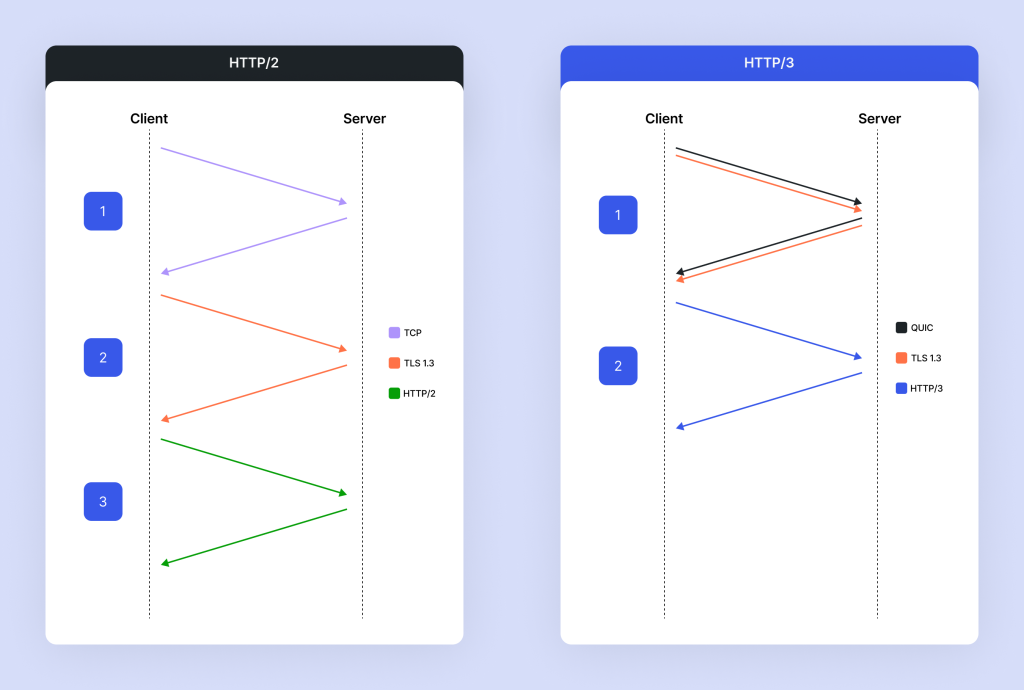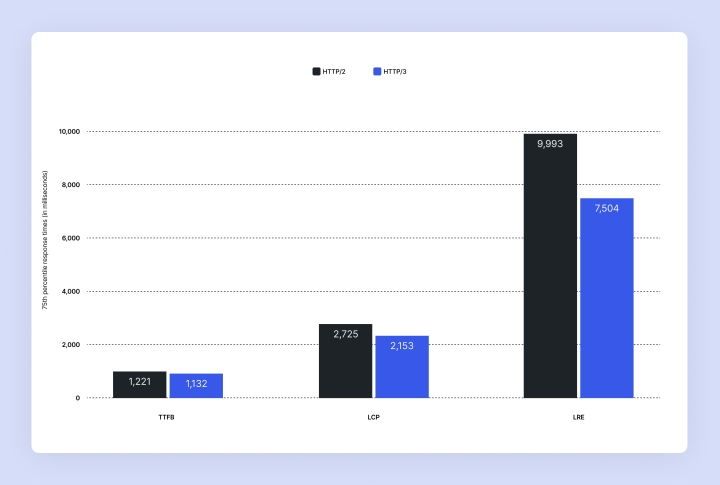Bringing You a Faster, More Secure Web: HTTP/3 Is Now Enabled for All Automattic Services
HTTP/3 promises performance enhancements like reduced latency, increased reliability, and improved security for users.
HTTP/3 is the third major version of the Hypertext Transfer Protocol used to exchange information on the web. It is built on top of a new protocol called QUIC, which is set to fix some limitations of the previous protocol versions. Without getting into technical details—though feel free to do so in the comments if you have questions—our users should see performance improvements across all metrics:
- Reduced latency. Due to faster connection establishment (i.e. fewer round-trips), latency from connection setup is lower.

- Multiplexing. That is, using a single connection for multiple resources. While this feature is present in HTTP/2, HTTP/3 has improved on it and fixed a problem called “head of line blocking.” This is a deficiency of the underlying protocol HTTP/2 was built on top, which requires packets to be in order before relaying them for processing.
- Reliability. Designed to perform better in varying network environments, HTTP/3 uses modern algorithms to help it recover faster from lost data and busy networks.
- Improved security. QUIC uses the latest cryptography protocols (TLSv1.3) to encrypt and secure data. More of the data is encrypted, which makes it harder for an attacker to tamper with or listen in on web requests.
Ultimately, HTTP/3 (on top of QUIC) has been designed to be updated in software, which allows for quicker improvements that don’t depend on underlying network infrastructure.
After about a month of preparing our infrastructure—including fixing bugs and upgrading our CDN—HTTP/3 was enabled for all of Automattic’s services on December 27th, 2023. It currently serves between ~25-35% of all traffic.
And now for some stats. For each of these, we want numbers to be lower after the switch, which ultimately means faster speeds across the board for our customers. Let’s look at three metrics in particular:
- Time to First Byte (TTFB) measures the time between the request for a resource and when the first byte of a response arrives.
- Largest Contentful Paint (LCP) represents how quickly the main content of a web page is loaded.
- Last Resource End (LRE) measures the time between the request for a resource and when the whole response has arrived.
Improvements look pretty good for fast connections:
- TTFB: 7.3%
- LCP: 20.9%
- LRE: 24.4%
For slow connections, the results are even better:
- TTFB: 27.4%
- LCP: 32.5%
- LRE: 35%
We are dedicated to providing our customer’s websites with the best possible performance. Enabling HTTP/3 is a step in that direction. See you on the QUIC side!
Automattic’s mission is to democratize publishing. To accomplish that, we’re hiring systems engineers to join the best infrastructure team on the planet. Learn more here.
- January 31, 2024
- Automattic



Quite commendable effort, HTTP/3
LikeLiked by 5 people
Hip hip hurah, zippity do dah!.
LikeLike
I read this…twice. I still do not know wth you said. just keep it working and I will be happy.
LikeLiked by 5 people
HTTP is, very basically, what allows users to load websites. So this new implementation is similar to the recent transition from 4G/LTE phones to 5G. It’ll be faster.
LikeLiked by 3 people
Good job, keep up with the effort
LikeLiked by 4 people
Thank you for helping us though these impressive improvements 🙏☦️
LikeLiked by 1 person
Hey,
your unsubscribe link is not working, screenshot in the attachment. Please remove me from your mailing list.
LikeLiked by 6 people
Hey there, you can unsubscribe from our mailing list using the Unsubscribe button in the email footer, or by managing your notification preferences here: https://wordpress.com/settings/notifications/
LikeLiked by 2 people
I’m not sure most of us understand yet 😆
LikeLiked by 3 people
Nice one
LikeLiked by 2 people
Thanks 🥰
LikeLiked by 2 people
This area is new to me but not completely foreign… reminds me of NTSC setup… captivating. I sense a future rabbit hole for me! Thanks for article
LikeLiked by 2 people
Great.
LikeLiked by 1 person
Great info very helpful
LikeLiked by 4 people
I definitely like this one better than the Jetset one.
LikeLiked by 1 person
Good
LikeLiked by 3 people
As a Jetpack subscriber and WordPress site, do we need to make any technical adjustments for this upgrade (http/3)?
LikeLiked by 2 people
Implementing HTTP/3 in WordPress isn’t something you can do yourself. It needs to be configured at the server level, usually by your hosting provider. Since we provide hosting for WordPress sites, we’re able to handle this for all sites hosted here. So, the initial step is to see if your hosting provider offers HTTP/3 support. I hope this information is helpful! If you have any further questions, feel free to ask.
LikeLiked by 1 person